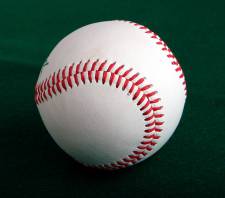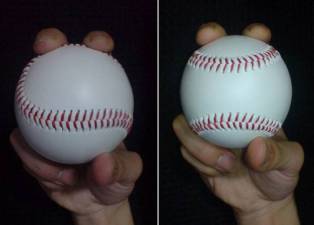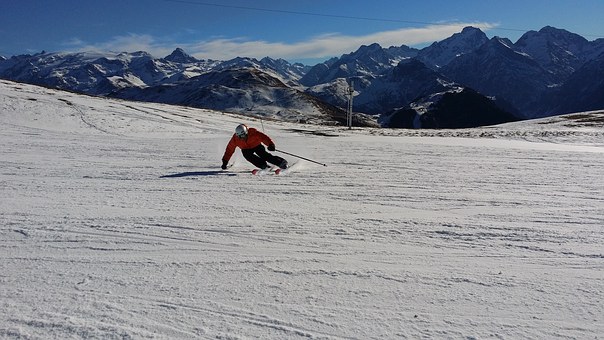In the Fall of 2002, Brian Amanatullah was a student at the University of Southern California, in his second year in Computer Engineering and Computer Science. He enjoys playing baseball and other sports.
In the Fall of 2002, Adam Nazar was a Computer Science and Computer Engineering major at the University of Southern California. His years of baseball experience and interest in engineering prompted him to undertake this project to further understand the physics behind the sport.
The art of pitching a baseball requires great skill and dexterity to master. A great pitcher is one who understands the engineering of the baseball itself and the aerodynamic principles at work while the ball is in flight. Furthermore, a great pitcher is able to exploit these laws of physics with a variety of pitches, each having a different velocity and trajectory. The pitcher uses different types of pitches to confuse the batter, thus gaining the upper hand. Two types of pitches that are very effective in allowing the pitcher to gain the advantage are the curveball and knuckleball. The curveball’s curving trajectory results from the direction of the ball’s spin, and the orientation of the stitches. On the other hand, the knuckleball relies on a very slow rotation and turbulent airflow. By understanding the structural engineering behind a baseball, the aerodynamics of the baseball, and the manner in which the ball is gripped and released, one can gain a greater appreciation for the science of pitching.
Introduction
Pitching a baseball is a finely honed skill, requiring great athleticism and years of practice to master. To pitch is not to merely throw the baseball across the plate, and even those who can throw with great speed and accuracy may not find success as pitchers. A great pitcher has an arsenal of pitches, each thrown with a different velocity and trajectory. With balls pitched at nearly 100 miles per hour, a batter has less than a second to determine what type of pitch it is, anticipate the location of the ball as it crosses the plate, and swing a 40 ounce bat over 100 miles per hour. An unpredictable pitch, then, can confuse a batter and give the pitcher a great advantage. Two such unpredictable pitches are curveballs and knuckleballs. These two types of pitches depend on the pitcher’s grip on the ball, the aerodynamics of the ball as it travels toward home plate, and the engineering behind the ball itself.
The Anatomy of a Baseball
A baseball consists of three main parts: the core, the shell, and the stitches. The outer portion of the baseball is what helps to create the curve in a curveball or the wildly erratic movement of a knuckleball . The core, which is a solid piece of cork with a nine inch circumference weighing roughly five ounces, is not relevant to the engineering of such pitches. The shell and stitches have the most effect on a ball’s flight through the air.The shell of the baseball is made up of two peanut-shaped pieces of cowhide, which are 8 inches in length and range in width from 2 inches at the larger end to 1 inch along the shorter parts (Fig. 1). They are extremely smooth and air travels over them easily. A baseball would be a nearly smooth sphere if not for the stitches used to connect these two pieces together.
The stitches of the baseball are used to sew the two pieces of the shell together around the inner core. The stitches form a pattern on the ball. The stitches wrap around the two peanut-shaped pieces to create a three dimensional outline of a hyperbolic paraboloid, which resembles a saddle. The stitches play an extremely important role in the flight of the ball through the air since they are responsible for altering the air flow around the ball [1].
Aerodynamics of a Baseball
Aerodynamics is defined as the “study of solid bodies moving through air” [2]. The aerodynamics of baseball, then, is the study of the flight of the ball through the air. If baseball were played in a vacuum, a pitch would be affected only by gravity, and thus the resulting path of the ball would be easily predictable. Since baseball is played in air, not a vacuum, the ball’s path is affected not only by the strength and accuracy of the pitcher’s arm, but also by the placement of the stitches as it flies through the atmosphere. “The drag exerted on a baseball by the air varies according to the ball’s velocity and the orientation of the stitches” [3]. By changing grips, a pitcher can change the air that flows around the baseball, resulting in a change of flight trajectory [4]. Thus, a pitcher can alter the ball’s aerodynamics by simply changing the way he holds and throws the ball.
The different ways of gripping the baseball, due to the continuous stream (Fig. 2), result in “different sectors of the stitching catch[ing] the air and induc[ing] drag-crisis transitions” [1]. A drag crisis transition is simply a departure from an object’s previous path and occurs when air pressures on the object change suddenly. Drag-crisis transitions are responsible for turbulence in airplanes. Anyone can experience drag-crisis transitions by placing their hand outside the window of a fast-moving vehicle. Pressure can be felt as the hand moves through the air. If the experimenter moves his or her hand, pressure will be exerted on a different area of the hand, causing a change in the turbulence surrounding the hand. Similarly, a drag crisis occurs on a baseball when a higher pressure builds up on a certain area of the ball, thus resulting in a force or “pull” on the ball.
Putting the Curve in Curveballs
The curving trajectory of a curveball results from two main factors: the ball’s spin and the orientation of the stitches. The ball must be spinning in the same direction it is travelling. On the under side of the ball, the airflow is moving in the same direction as the spin of the ball and hence the air moves faster, decreasing pressure. On the top of the ball, the airflow is moving in the opposite direction of the spin, and so the air moves slower, increasing pressure.
The net effect is a drag crisis transition in which force is exerted toward the side of less air pressure–the bottom of the ball. This downward force results in a gradual downward curve. The orientation of the stitches enhances this effect. When correctly positioned, the stitches increase resistance along the top side of the ball, creating even more increased pressure. This aerodynamic phenomenon is comparable to that of an airplane wing. An airplane wing’s top edge is curved so that the air flows over it faster, which results in a lower pressure than the under edge. Because of the lower pressure on the top edge, there is a force from the higher pressure area, resulting in a lift. In much the same way, a curveball uses air pressures to curve. By generating greater air speed, and hence less air pressure on one side, the ball will curve in that direction. Instead of a curved wing, spinning the ball with a particular stitch orientation creates a curveball’s change in pressure.
Techniques Behind the Curveball
A curveball can be created as long as the seams are positioned so that the airspeeds around the ball are altered. “Depending on how the pitcher grips the ball, either two lines [a two-seam curveball] or four lines [a four-seam curveball] of stitching pass across the face of the spinning ball with each revolution” [5]. Pitchers generally consider the four-seam curveball more effective [5]. “A four-seam pitch curves up to three times as much as a two-seam pitch with the same velocity” [6]. The greater efficacy of the four-seam curveball is confirmed by the aerodynamic properties examined above. The two-seam curveball only has two seams rotating with the direction of spin, while the four-seam curveball has four — twice the number of seams to aid in creating a drag-crisis transition. As the air comes in contact with more seams, greater pressure alterations occur around the ball, resulting in a bigger curve.
The grip of the baseball is critical in the creation of a curveball, for it allows the pitcher to produce the four lines of seams (Fig. 3) rotating over the face of the baseball. The four-seam curveball grip requires the use of the index finger, middle finger, and the thumb. The pitcher places his middle finger on a seam, while his index finger rests next to it. It is important not to apply pressure with the index finger, if possible, but only rest it for support. The pitcher’s thumb should be placed directly on the opposite seam of the middle finger, so the fingers and thumb create a “C” around the ball. The thumb should remain relaxed, in order to place most of the pressure on the middle finger when thrown [7] . The pitcher’s other two fingers are placed under the ball for support, to make the grip more comfortable and keep the ball in place.
A pitcher can choose to throw the ball at any angle in order to confuse the batter. However, it is very important to keep the hand behind the ball as long as possible to create the spin at the release point [7]. This technique can be compared to cracking a whip. When a whip is cracked, the hand is kept behind the whip until the last moment, when it is thrown foreword. Sidebar PopupThe air at the end of the whip is accelerated, thus emitting a “cracking” sound. Similarly, by keeping the hand behind the ball, then snapping the baseball at the release point, the spin of the ball will be maximally accelerated. The pitcher must literally snap his fingers at the release of the ball. As with cracking a whip, snapping the ball out of the hand will apply the maximum centripetal, or circular, force to the ball. With this key technique, a pitcher can throw one of the most elusive pitches in baseball.
A Knuckleball’s Unpredictable Path
When properly thrown, a knuckleball “seems to make up its own rules on its way to the plate. It floats, flutters, twitches, lurches, and dives” [8]. This improbable behavior was once discounted as baseball lore, but “scientists have recently proven that a knuckleball can veer more than once in flight” [8]. While a successful curveball spins rapidly, “an effective knuckleball should be thrown so that it rotates less than once on its path to home plate” [9]. It is this very slow rotation that is responsible for the erratic and unpredictable trajectory that has baffled physicists, as well as batters, for decades.
If baseballs were entirely smooth spheres, pitches with little or no spin would move through the air on a predictable and straight path. However, as with curveballs, the stitches interact with the air, “creating turbulence in the airflow” passing over the moving ball [8]. Scientists have confirmed that when a baseball “is thrown with very little rotation, asymmetric stitch configurations can be generated that lead to large imbalances of forces and extraordinary excursions in trajectory” [1]. In other words, as the baseball slowly spins, different seam configurations are exposed to the flow of air around the ball, causing a disturbance or change in the air flow, which creates sudden changes in the ball’s path. As one analyst notes: At first, the seams’ aerodynamic influence might be pushing the ball outside, away from the plate; then, suddenly, a small shift in the seams might reverse the force, causing the ball to plunge back across the inside [8].
These deflections of the baseball are directly dependent on the amount of spin. If the ball rotates too quickly, it acts as a rough sphere with no distinguishable obstructions for the airflow to hit and move the ball. A ball with too much spin will simply follow the path dictated by the spin of the ball, and is very unlikely to overcome inertia and change its trajectory. The seams must slowly be exposed to air in order to create significant airflow disturbances. Too little spin is also problematic; without any spin, the ball “can only curve laterally in one direction. The maximum deflection will be dependent only on the initial orientation of the baseball” [9]. Since the knuckleball’s unpredictable movement depends on a change in the seam configurations exposed to airflow, a lack of rotation causes no changes in airflow and, subsequently, no movement. The precision required to throw a true knuckleball makes it one of the most difficult pitches to throw successfully.
Techniques Behind the Knuckleball
To throw a knuckleball, follow these four main steps:
1. Fingernails — Grip the baseball by clenching it just below the seams with the tips of the middle, index, and ring fingers. Dig the fingernails deeply into the ball.
2. Thumb Position — Place the thumb below the ball to give it support while keeping the pinkie off to the side.
3. Stiff Wrist — Throw the ball with a stable and stiff wrist to eliminate as much spin as possible.
4. Extend Fingers — Extend all fingers toward home plate in a pushing motion as the ball is released.
Contrary to what the name suggests, today most pitching instructors and experts recommend gripping the ball with the fingernails or fingertips instead of with the knuckles. The ball should be “pushed” at medium speed (55-72 miles per hour) toward the plate as if throwing a shot put. If correctly thrown, the ball should rotate between one half and one full rotation along its path. This is no simple task; it takes years of practice to throw a knuckleball consistently.
Conclusion
Good pitching is essential to a baseball team’s success. Since pitchers are more prone to fatigue than other fielders, most professional baseball teams include 12-13 pitchers on a 25-man roster. While difficult, mastering unpredictable pitches such as curveballs and knuckleballs increases a pitcher’s efficacy. Such pitches are no optical illusion or baseball myth, but rather the result of the same aerodynamic properties at work in the lift on a airplane wing. The orientation of the baseball’s seams can create a drag-crisis transition, resulting in a changing trajectory. A ball’s spin, or lack thereof, plays a key role in determining the nature of that change, whether it is smoothly curving or wildly erratic. Whether playing or watching baseball, anyone can appreciate not only the importance of pitching to America’s favorite pastime, but the scientific principles behind baseball’s most complex pitches.
References
[1] Robert K. Adair. “The Physics of Baseball.” Physics Today. 48 (May 1995): 26-31.
[2] Oxford. The Oxford Pocket Dictionary and Thesaurus. American ed. New York: Oxford University Press: 1997.
[3] “Knuckleballs.” Scientific American. 257 (July 1987): 22.
[4] Alan M. Nathan. “Baseball Pitches.” Scientific American. 277 (Sept 1997): 102-3.
[5] Peter Weiss. “Pitching Science.” Science News 159 no. 23 (June 2001): 366.
[6] Andy Fell. “Engineers Study Baseball Flight.” Global Technoscan. Apr. 2001 8 Mar 2001. <http://www.globaltechnoscan.com/18thApr-24thApr01/baseball.htm>.
[7] Jim Katt. “The Mechanics of a Breaking Pitch.” Popular Mechanics. Apr. 1997 8 Mar 2001. <http://popularmechanics.com/popmech/sci/9704STSSAM.html>.
[8] Richard Flaste (ed). “Why does the knuckleball behave that way?” The New York Times Book of Science Literacy.New York: Time Books, 1991. 364-8.
[9] Robert G. Watts. “Aerodynamics of a Kunckleball.” American Journal of Physics. November 1975: 960-3.
[10] A. Terry Bahill and Robert G. Watts. Keep Your Eye on the Ball. New York: W. H. Freeman and Company, 1990.






